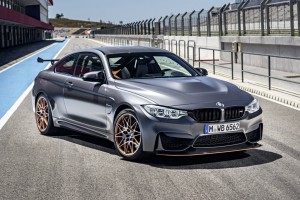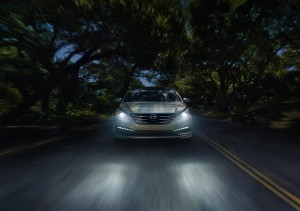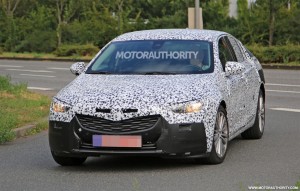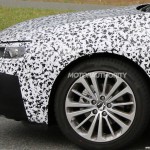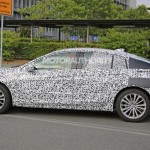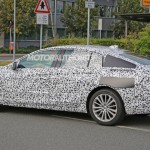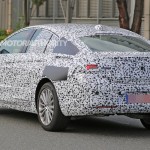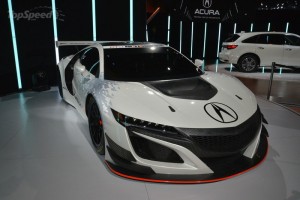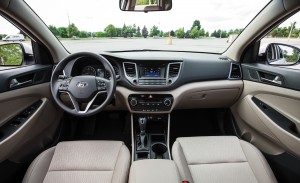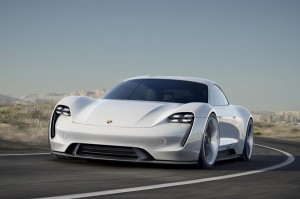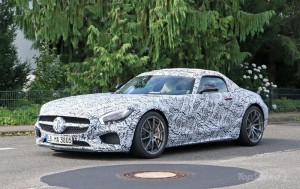Monthly Archives: August 2016
Mercedes-Benz G-Class Is Finally Getting Updates For 2018
It looks like the Mercedes-Benz G-Class, the Geländewagen, is receiving major, generational change updates. It has been around for 40 years, first used by Germany’s military forces and then later on, as the go-to vehicle of the rich and famous in Rodeo Drive.
Even AMG has a version of the SUV—the powerful G65 AMG with twin-turbocharged V-12 and G65 AMG 6×6 with three Portal axles and pickup bed.
The new spy shots revealed that the new G-Wagen will be wider and longer than the current version. There might also be new underpinnings. At first sight, the G-Wagen doesn’t look that much difference in size to the current model but putting them side by side would reveal that the mule is much wider.
This is apparent on the test mule’s front end that expands outward from a narrow grille, and the extra space on either side of the headlights.
But don’t worry, the iconic look will remain because there is still that wide fender flares, low beltline, almost vertical windshield, and flat side glass and roof.
There are no spy shots of the interior just yet, but we can expect the new G-Wagen to have the same fittings as the S-Class and E-Class sedans, plus the extra room. But despite the new interior space, don’t expect Mercedes to try to fit in a third row. Most likely, there will be cargo space after the second row.
As for powertrains, the G-Wagen will have a number of options—both diesel and gasoline. In the US, the main engine will most probably be a 4.0-liter biturbo V-8 that produces 416 horsepower and 450 pound-feet of torque. This then will be paired with Mercedes’ seven-speed automatic transmission. 4WD will come standard on this model.
It’s still early to estimate prices, but we expect the G-Wagen to start at $125,000.
Rolls-Royce Wraith Receives Makeover From Bespoke
After several special editions, the Rolls-Royce Wraith is receiving another makeover from Bespoke. But this time, it aims to be “one-of-a-kind,” and will be a part of Bespoke’s theme called “Dusk Until Dawn.”
The unique Wraith was unveiled at the Rolls-Royce’s exclusive Summer Studio event in Porto Cervo, Italy, thus it was dubbed as the Rolls-Royce Porto Cervo Wraith according to a report.
To represent the “Dusk” in the theme, the Wraith is finished in two-tone silver exterior, with the engine hood and the roof being just a bit darker than the rest of the car’s body. But what separates the Wraith cannot be found on its exterior as it is far more impressive once you go inside.
Upon entering, you’ll be greeted by the “Porto Cervo Wraith–One of One” insert in the door sill. Everything is finished in shades of blue, purple, slate and black. In detail, you’ll see that the inside is made of ostrich leather and fine wood veneer. The four seats are wrapped in purple leather with white stitching and silver “RR” logos on the headrests.
But the main highlight comes from the infotainment system, where Bespoke placed the emblem of Porto Cervo made of emerald stones, mother of pearl and white gold. The upper dashboard is similar with emerald-like top and white lower section.
Anyone who buys the Porto Cervo Wraith will receive a leather headrest designed by London-based artist Mo Coppoletta.
Under the hood, you’ll find Wraith’s standard engine and transmission—6.6-liter V-12 that can produce 623 turbocharged horsepower and 590 pound-feet of torque, which allows the coupe to go from 0 to 60 mph in just 4.4 seconds. It has a top speed of 186 mph.
There’s no information about pricing yet, but let’s expect this new Wraith to start at $500,000.
Check out some of its photos in the gallery below:
BMW M4 GT4 To Join The Race Tracks In 2018
German automaker BMW is set to launch an M4 GT4 race car just in time for the 2018 motorsport season. The company is planning to join the growing list of automakers that are now offering race cars with the FIA GT4 specs.
This car, according to a report, will be the successor to the M3 GT4 that they started to offer in the last decade. There was a single teaser released, though not much can be seen there. It only showed that the M4 GT4 will closely resemble the M4 GTS road car that was launched in 2015.
The M4 GT4, however, will not be far off tech- and spec-wise from the standard M4 to keep costs and reliability relatively close. The drivetrain, the entirety of it, will be the same with the standard car. Yes, even the electronics.
This means the race car will come packed with a twin-turbocharged 3.0-liter inline-6 that produces 425 horsepower.
Of course, joining the tracks means BMW has to somehow set the M4 GT4 apart from the usual road cars. This resulted to the addition of carbon fiber body panels, an aggressive front splitter and rear wing, a high-flow exhaust system, uprated brakes, and a stripped-out interior.
Jens Marquardt of BMW motorsport said that it was easy for the company to finally decide to come up with the GT4 race car. The German automaker apparently wants to capitalize on the current attention being given to the GT4. It also aims to provide up-and-coming racers an “affordable alternative” to the GT4 race cars produced by Aston Martin, KTM, Lotus, McLaren and Porsche.
The M4 GT4 will begin its testing later this year since it wants to debut at the 24 Hours of Dubai in January 2018. The car will presumable meet the requirements set by various GT4 competitions in Asia, Europe and North America.
The M4 GT4 will be part of BMW’s customer racing portfolio, which will also include the M235i Racing and the M6 GT3.
2017 Hyundai Sonata Adds Dynamic Headlights For Better Driving
Hyundai tweaked a little something in their 2017 Sonata. The addition of dynamic headlights will enable better driving, the Korean automaker believes.
The headlights will turn their beams up when the driver turns a corner, according to a source. This will help the driver see the road around the bend more clearly than before. Although only available on the top-of-the-line Sonata Limited, these dynamic headlights are especially helpful for drivers with eyesight problems.
Aside from the headlights, Hyundai announced some pricing and equipment adjustments across the Sonata range. These changes will come in full effect in this new model year.
Last year, the Hyundai Sonata was offered in one of three four-cylinder engines: a 2.4-liter four-cylinder that can produce 185 horsepower, a 2.0-liter turbocharged four-cylinder engine that can come up with 245 horsepower, and a 1.6-liter turbocharged four-cylinder with 178 horsepower. The last one is exclusive only to the fuel-efficient Sonata Eco.
The 2.4-liter and 2.0-liter engines are paired with a six-speed automatic transmission while the 1.6-liter engine will work together with a seven-speed dual-clutch automatic transmission to swap gears.
According to Hyundai, the entry-level Sonata’s price will rise by $300 to $22,435 while the SE will cost $200 more than the previous $22,785. The Eco models will cost less, on the other hand. Previously priced at $23,960, it will now cost less than $600 last year.
The Sport edition with the 2.0-liter turbo engine dropped by $2,325 to $27,435, though the Sport trim with the 2.4-liter engine stayed at $24,235.
Why the price drops? Hyundai decided to delete some standard features in previous models such as the HID headlights, LED taillights, proximity key, dual-zone climate control, and a blind spot monitor.
If you want the Sonata Limited, it will now cost $27,985, $200 less than the 2016 model. Consumers can choose to add the dynamic headlights, but this will be a part of the $3,400 Technology package, which will also include heated and vented front seats with memory, a navigation system, and more.
The Limited 2.0T has the Technology package plus more. It remains at $34,910.
Spy Shots Of 2017 Opel Insignia Released
The new 2017 Opel Insignia has been spotted about to be tested by car engineers. It was initially designed to compete in the mid-level sedan race, but the new model can also rival some larger models because of its relatively larger size. It looks like Open designed the sedan with a coupe-like profile too like the Audi A7.
Despite its bigger size as shown in the spy shots, the new Insignia should be lighter and more dynamic than the current model, largely thanks to the E2XX platform, which made its debut in the 2016 Chevrolet Malibu. The platform was made to endure high-strength steel in its construction, allowing the Malibu to have about 300 pounds of savings in weight. The same can be expected for the new Insignia.
As for the drivetrains, front-wheel drive will be the standard, but there will also be an option for an all-wheel drive. There are speculations that the power would come from a 3-, 4- and 6-cylinder configurations, both in diesel and gasoline flavors.
A hybrid option and a sporty OPC are rumored. The latter is expected to be paired with the Regal GS.
Remember Opel’s Monza concept from 2013 and the more recent GT concept? The new Insignia will be likely influenced by these. We should see features such as Matrix LED headlights, semi-autonomous systems and an infotainment system with smartphone connectivity.
Plans are also being made for an Insignia Sports Tourer Wagon, which might be brought to the US as a new Buick wagon.
This new model is crucial for General Motors since the Insignia is sold both in Europe, US and China where it is called the Buick Regal.
The new Insignia is expected to make its debut late this year or early next year. There might be an appearance at the 2016 Paris Auto Show in September, though no confirmation has been made yet.
2017 Acura NSX GT3 Race Car Shows Up At NY Auto Show
It was safe to assume we’ve seen the last of the Acura NSX because it has just went on sale last month with the launch of its online configuration. But then, it just showed up at the New York Auto Show with a GT3 variant of the Acura NSX. There was an announcement too that Acura plans to turn this model into a GIA GT3 race car this fall based on a report.
In terms of overall design, there is almost no difference between the NSX and the NSX GT3, except for the latter’s new hood that sports a larger vent for cooling down the engine. The fascias, headlights and front grille are also the same. What’s new is the larger front spoiler that extends several inches away from the fascia, giving the NSX GT3 a more truck-like appearance.
On the sides, the GT3 is more toned down than the NSX. The mirror arm sits almost vertical and the mirror housing is smaller. The aggressive body line we’ve seen on the NSX is no more. Instead, it has been toned down to fit the smoother side skirts that transition into the rear wheel arches and the rear quarter panels. This was probably done to assist in air distribution.
To make it lightweight, the GT3 was wrapped with a lightweight, aluminum-intensive space frame. The main color is white, though there are black accents around the grille and the fascia’s flics, hood vent and rear air intakes.
There is not much information yet about the drivetrain, though we have a thinking that the GT3 will be powered by a 3.5-liter, 75-degree, twin turbo DOHC V-6 that has the same engine specs as the road-going NSX. The engine block, cylinder heads, valvetrain, crankshaft and pistons will be similar as well.
The current road-going NSX can produce 573 horsepower and 476 pound-feet of torque. The GT3 will most likely upgrade these figures.
We can base the GT3’s future pricing to the Porsche 911 GT3 R, which has a current price tag of $479,216.
Hyundai Tucson Mildly Updated For 2017
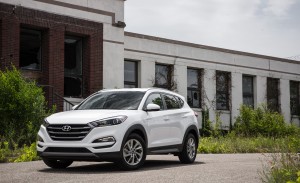
2016 Hyundai Tucson Eco AWD (Source: CarAndDriver)
The redesigned 2016 Hyundai Tucson sold like pancakes this year. Its sales have doubled compared with the numbers it posted from last year until June 2016. The Korean automaker didn’t need to change much for its smallest crossover, seeing as it has been wildly successful in its target market.
Luckily, Hyundai heeded the sales figures, and only gave minor interior tweaks to the 2017 edition. These tweaks included the Android Auto and Apple CarPlay availability, as well as a new audio system and barely noticeable revisions to the cabin.
It’s a welcome development to see Apple’s and Android’s smartphone compatibility software with the new Tucson, although it’s kind of a bummer that this integration is only available on the top Limited trim level. Of course, there are third-party companies that can install the software in your lower-Limited Tucson trim, but it’s just not the same as getting it straight from the source.
The Tucson Limited is the only model that has a larger 8-inch touchscreen with navigation compatibility with the Apple CarPlay and Android Auto tech. The other trim levels—the SE, Eco and Sport—are stuck with the mediocre 5-inch touchscreen that includes a backup camera and Bluetooth audio streaming.
Hyundai also announced recently that it has software updates to retroactively add Apple CarPlay and Android Auto to current Tucson models, but that also means it will only be available for the top trim level.
There’s another new development for the 2017 Tucson, and that’s the 315-watt Infinity audio system. This, unfortunately, is also reserved for the Limited trim level. But don’t worry if you only have the budget for the Tucson Eco and Tucson Sport since these models now come standard with rear-seat air vents. The Sport will now also come packed with the Limited’s door panels.
The exterior and powertrains remain the same, but that’s completely okay since Tucson is powered by 1.6-liter turbo four-cylinder standard on Eco, Sport and Limited. Prices stay the same for the SE ($23,595) and the Eco ($25,045) while the Sport ($26,795) and Limited ($30,670) are actually a couple of bucks cheaper than the previous tags.
Baby Porsche Panamera Could Be The Future All-Electric Mission E
There are reports that the baby Porsche Panamera mule, nicknamed the Pajun, could be the development car for the all-electric Mission E. The appearance of the mule in spy photos proved speculations that the development of the Pajun is back on track after it was shelved in 2014.
Apparently, the Pajun will be arriving in 2019. It is just in time for the planned launch of the production Mission E, which Porsche plans to sell before the end of the decade as a rival to the Tesla Model S. With this coincidence, there are now talks that despite the exhaust tailpipes on the Porsche Panamera mule, this could very well be the foundation for the Mission E.
This isn’t such a surprise as car makers have, for years, tried to lure their competitors through false pretenses. The tailpipes could very well be there to confuse the stockholders in the market, as well as to hide what’s really under the mule’s body.
This latest sighting pushed the luxury automaker company to remain even more mum about the Panamera mule and the possibility that it could be the all-electric Mission E. This attitude has only led sources and experts to believe that the latest photos showed the Mission E in an advanced development stage—road-based testing.
It would only mean that the German automaker is right on schedule to debut the all-electric vehicle by 2019. This would be the perfect time to give the Tesla Model S a run for its money.
We don’t have exact details yet of the technical specifications that the Mission E will come packed with, but expect the vehicle to have a lithium ion battery that can power the car to a range of more than 330 miles. Combined with two electric motors, Porsche’s all-electric car can go 0-62 mph in just 3.5 seconds.
2018 Mercedes-AMG GT Roadster To Arrive In 2017
The roadster version of the Mercedes-AMG GT series is scheduled to arrive by 2017, spy shots confirmed. There were rumors earlier that the German luxury automaker plans to skip building an AMG GT Roadster to protect its SL-Class Roadster, which hasn’t been doing well in the market.
However, the new spy shots just proved that the roadster is indeed coming as anticipated. This isn’t that surprising because Mercedes developed the GT with the Porsche 911 Turbo as competition. Since Porsche came out with a drop-top version of the range-topping model, Mercedes will have to follow suit if it doesn’t want to lose the challenge.
On the outside, the Mercedes-AMG GT roadster has a slightly longer deck lid and it will also come without its fixed roof. The soft top will be similar to the shape of the SLS AMG. This is a minor change from the current version, but it does ensure that the body style can transition without exactly ruining the car’s sleek appearance.
Inside, the roadster will enjoy the same aviation-inspired theme with the wing-like dashboard with spotlight-style A/C vents in the center stack. There are also the concave-shaped door panels and the motorsport-inspired center console that is stacked with the AMG Drive Unit controls.
Passengers will get to experience the luxurious seating made of high quality materials that include leather, Alcantara, contrast stitching, and exemplary fit and finish. This elegant interior will be finished off by the “infinite” headroom, thanks to the option of a removable roof.
The infotainment system will also be very similar to the coupe and it will include the latest apps and features.
Under the hood, you’ll find Mercedes-AMG’s twin-turbocharged, 4.0-liter V-8 that can churn out 456 horsepower and 443 pound-feet of torque. The AMG GT S version will get you 503 horsepower and 479 pound-feet of torque.
There is no information yet about the pricing though it is expected that the GT S Roadster will debut at $137,000.













